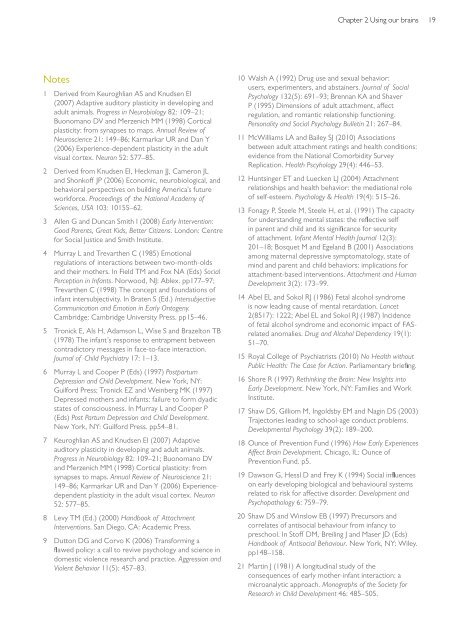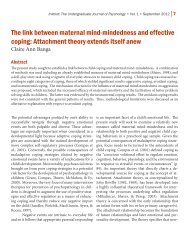early-intervention-next-steps
early-intervention-next-steps
early-intervention-next-steps
Create successful ePaper yourself
Turn your PDF publications into a flip-book with our unique Google optimized e-Paper software.
Notes<br />
1 � Derived from Keuroghlian AS and Knudsen EI<br />
(2007) Adaptive auditory plasticity in developing and<br />
adult animals. Progress in Neurobiology 82: 109–21;<br />
Buonomano DV and Merzenich MM (1998) Cortical<br />
plasticity: from synapses to maps. Annual Review of<br />
Neuroscience 21: 149–86; Karmarkar UR and Dan Y<br />
(2006) Experience-dependent plasticity in the adult<br />
visual cortex. Neuron 52: 577–85.<br />
2 � Derived from Knudsen EI, Heckman JJ, Cameron JL<br />
and Shonkof JP (2006) Economic, neurobiological, and<br />
behavioral perspectives on building America’s future<br />
workforce. Proceedings of the National Academy of<br />
Sciences, USA 103: 10155–62.<br />
3 � Allen G and Duncan Smith I (2008) Early Intervention:<br />
Good Parents, Great Kids, Better Citizens. London: Centre<br />
for Social Justice and Smith Institute.<br />
4 � Murray L and Trevarthen C (1985) Emotional<br />
regulations of interactions between two-month-olds<br />
and their mothers. In Field TM and Fox NA (Eds) Social<br />
Perception in Infants. Norwood, NJ: Ablex. pp177–97;<br />
Trevarthen C (1998) The concept and foundations of<br />
infant intersubjectivity. In Braten S (Ed.) Intersubjective<br />
Communication and Emotion in Early Ontogeny.<br />
Cambridge: Cambridge University Press. pp15–46.<br />
5 � Tronick E, Als H, Adamson L, Wise S and Brazelton TB<br />
(1978) The infant’s response to entrapment between<br />
contradictory messages in face-to-face interaction.<br />
Journal of Child Psychiatry 17: 1–13.<br />
6 � Murray L and Cooper P (Eds) (1997) Postpartum<br />
Depression and Child Development. New York, NY:<br />
Guilford Press; Tronick EZ and Weinberg MK (1997)<br />
Depressed mothers and infants: failure to form dyadic<br />
states of consciousness. In Murray L and Cooper P<br />
(Eds) Post Partum Depression and Child Development.<br />
New York, NY: Guilford Press. pp54–81.<br />
7 � Keuroghlian AS and Knudsen EI (2007) Adaptive<br />
auditory plasticity in developing and adult animals.<br />
Progress in Neurobiology 82: 109–21; Buonomano DV<br />
and Merzenich MM (1998) Cortical plasticity: from<br />
synapses to maps. Annual Review of Neuroscience 21:<br />
149–86; Karmarkar UR and Dan Y (2006) Experiencedependent<br />
plasticity in the adult visual cortex. Neuron<br />
52: 577–85.<br />
8 � Levy TM (Ed.) (2000) Handbook of Attachment<br />
Interventions. San Diego, CA: Academic Press.<br />
9 � Dutton DG and Corvo K (2006) Transforming a<br />
fawed policy: a call to revive psychology and science in<br />
domestic violence research and practice. Aggression and<br />
Violent Behavior 11(5): 457–83.<br />
Chapter 2 Using our brains 19<br />
10 Walsh A (1992) Drug use and sexual behavior:<br />
users, experimenters, and abstainers. Journal of Social<br />
Psychology 132(5): 691–93; Brennan KA and Shaver<br />
P (1995) Dimensions of adult attachment, afect<br />
regulation, and romantic relationship functioning.<br />
Personality and Social Psychology Bulletin 21: 267–84.<br />
11 McWilliams LA and Bailey SJ (2010) Associations<br />
between adult attachment ratings and health conditions:<br />
evidence from the National Comorbidity Survey<br />
Replication. Health Pscyhology 29(4): 446–53.<br />
12 Huntsinger ET and Luecken LJ (2004) Attachment<br />
relationships and health behavior: the mediational role<br />
of self-esteem. Psychology & Health 19(4): 515–26.<br />
13 Fonagy P, Steele M, Steele H, et al. (1991) The capacity<br />
for understanding mental states: the refective self<br />
in parent and child and its signifcance for security<br />
of attachment. Infant Mental Health Journal 12(3):<br />
201–18; Bosquet M and Egeland B (2001) Associations<br />
among maternal depressive symptomatology, state of<br />
mind and parent and child behaviors: implications for<br />
attachment-based <strong>intervention</strong>s. Attachment and Human<br />
Development 3(2): 173–99.<br />
14 Abel EL and Sokol RJ (1986) Fetal alcohol syndrome<br />
is now leading cause of mental retardation. Lancet<br />
2(8517): 1222; Abel EL and Sokol RJ (1987) Incidence<br />
of fetal alcohol syndrome and economic impact of FASrelated<br />
anomalies. Drug and Alcohol Dependency 19(1):<br />
51–70.<br />
15 Royal College of Psychiatrists (2010) No Health without<br />
Public Health: The Case for Action. Parliamentary briefng.<br />
16 Shore R (1997) Rethinking the Brain: New Insights into<br />
Early Development. New York, NY: Families and Work<br />
Institute.<br />
17 Shaw DS, Gilliom M, Ingoldsby EM and Nagin DS (2003)<br />
Trajectories leading to school-age conduct problems.<br />
Developmental Psychology 39(2): 189–200.<br />
18 Ounce of Prevention Fund (1996) How Early Experiences<br />
Afect Brain Development. Chicago, IL: Ounce of<br />
Prevention Fund. p5.<br />
19 Dawson G, Hessl D and Frey K (1994) Social infuences<br />
on <strong>early</strong> developing biological and behavioural systems<br />
related to risk for afective disorder. Development and<br />
Psychopathology 6: 759–79.<br />
20 Shaw DS and Winslow EB (1997) Precursors and<br />
correlates of antisocial behaviour from infancy to<br />
preschool. In Stof DM, Breiling J and Maser JD (Eds)<br />
Handbook of Antisocial Behaviour. New York, NY: Wiley.<br />
pp148–158.<br />
21 Martin J (1981) A longitudinal study of the<br />
consequences of <strong>early</strong> mother-infant interaction: a<br />
microanalytic approach. Monographs of the Society for<br />
Research in Child Development 46: 485–505.



